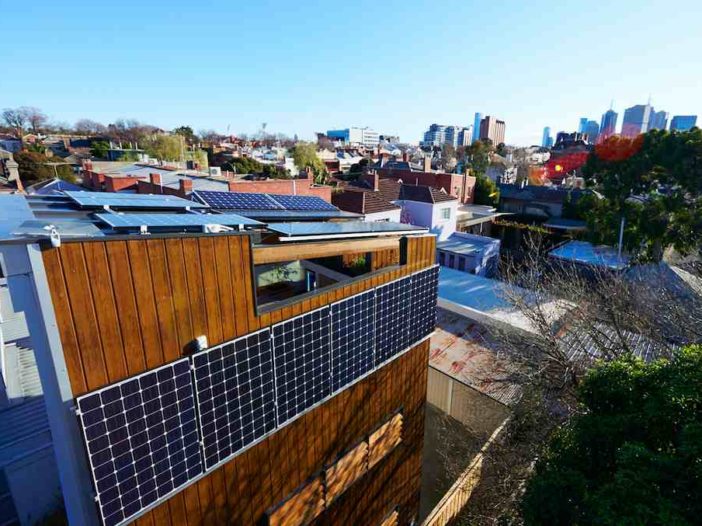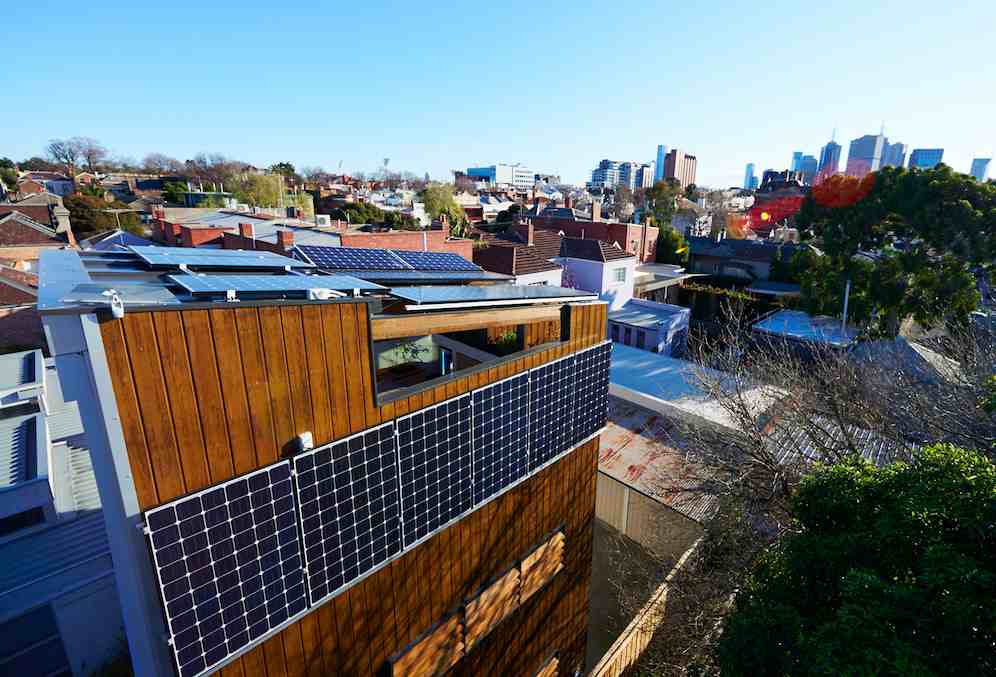
Photographer Ralph Alphonso had planned to turn a small inner city property space – just 5 metres by 4 metres – next to his inner city photographic studio in east Melbourne into a car port with a roof. Instead, after prompting from his father, he came up with a better idea.
 He calls it the 5×4 concept. Over three levels, he has replaced the existing lean-to storage shed with a three-level living area of 60 square metres. Add in a rooftop garden with a plunge pool/spa and shading from his solar PV array, he has a total of 80 square metres to live in.
He calls it the 5×4 concept. Over three levels, he has replaced the existing lean-to storage shed with a three-level living area of 60 square metres. Add in a rooftop garden with a plunge pool/spa and shading from his solar PV array, he has a total of 80 square metres to live in.
It is a unique inner city dwelling set on an unusually small physical footprint and designed, built and powered with passive and active eco-driven processes, materials and performance considerations. It is based on the One Planet Living principles and was presented at the United Nations Sustainable Development Conference in Rio in 2012.
Alphonso moved in to the new dwelling a month ago. “It is not some hippy house that no one wants to live in,” he says. “I am happy to live in that space.” And it has all the mod cons.
For electricity, it features 15 solar panels totalling 3.5kW. Six of the panels are mounted vertically on the north facing outside wall, with another nine in various angles on the rooftop, to create shading and to allow the sun in during winter.
 Because the house uses so little electricity (he is not saying exactly how much until he has lived there for a few months), it is a net exporter.
Because the house uses so little electricity (he is not saying exactly how much until he has lived there for a few months), it is a net exporter.
Early next year, Alphonso will install 2 or 3 Enphase battery storage systems (they come in modular size of 1.25kWh) to take more charge over his energy supply. He won’t go off grid, because he would need a lot more storage to achieve full independence, and it would not be economic.
One of the reasons that the home uses so little electricity is because of its geothermal heat pump that provides “climate control” – at just 200 watts – and the “airtight” nature of the building. When we visit it is 35C outside and blowing a gale. The house is a comfortable 22C.
Alphonso also uses the best appliances. A clothes dryer that uses less electricity than the washing machine, an induction cook top, a combined micro-wave/oven, and a pop-up TV screen. LED lighting is used and there is no gas.
But he laments the fact that his new home only scores a “six star” rating under Australian standards, despite it being carbon neutral and likely to be net energy positive.
He says Australian standards ignore things like “air-tight” building, and geothermal heat pumps. These standards are commonplace in Europe, but apparently Australia does not adopt them because it does not consider itself an “extreme climate.”
Alphonso begs to differ, pointing to the heat and wind on the day of the visit. “Architects say that air tight buildings are not needed, but that is simply not true. I’m trying to change that thinking.”
 Alphonso believes that consumers will go green as long as it does not affect the hip pocket, and does not affect their lifestyle. He is trying to prove that both is possible with this new design.
Alphonso believes that consumers will go green as long as it does not affect the hip pocket, and does not affect their lifestyle. He is trying to prove that both is possible with this new design.
And he says it it critical to look at the full “life cycle” of the technologies adopted. That is why he would not go “off-grid” because of the need for extra batteries. He notes that the full life cycle of a Prius is not that different from a Landcruiser. “You don’t want to rob Peter to pay Paul.”
He has 100 per cent green energy through his own production, but also the around 40 per cent of needs that needs to be imported from the grid. He uses Diamond Energy.
“I am an accidental environmentalist. I used to race cars, and motorcycles, but if you look at the environment like you look at the economy, you can effete change.
Giles Parkinson is founder and editor of One Step Off The Grid, and also edits and founded Renew Economy and The Driven. He has been a journalist for 35 years and is a former business and deputy editor of the Australian Financial Review.



